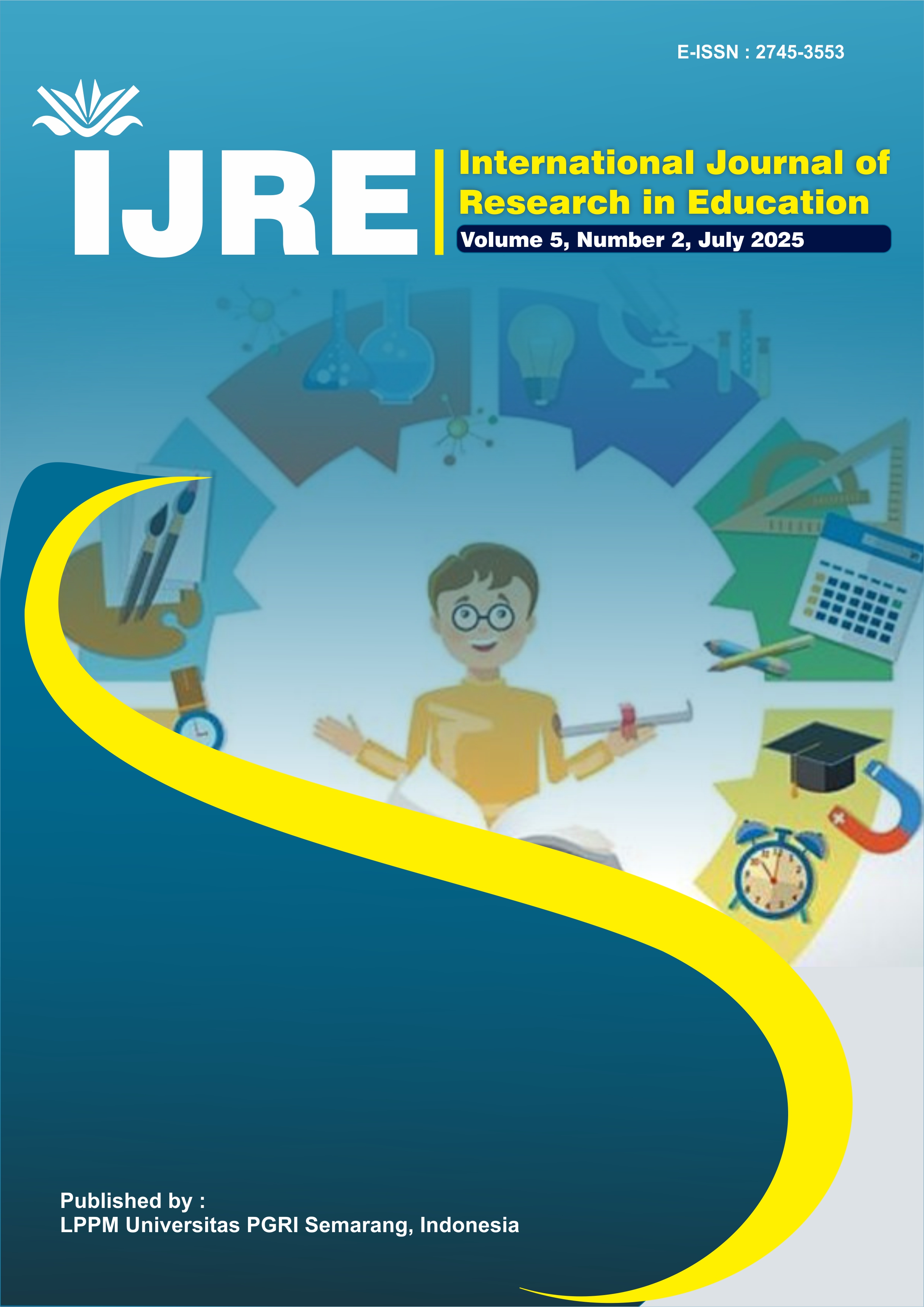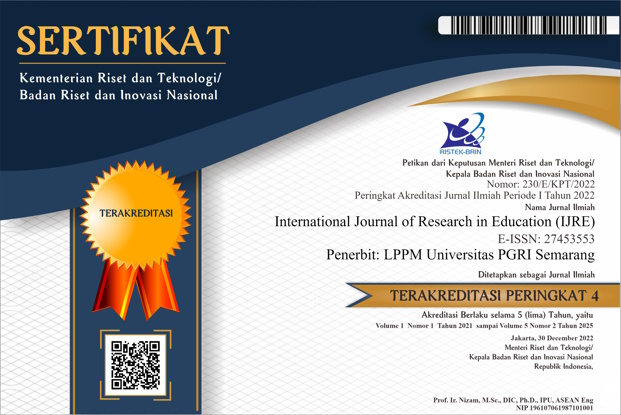An EFL Teacher Using Gestures to Teach English at a Vocational High School in Indonesia
DOI:
https://doi.org/10.26877/r8339r02Keywords:
Gestures, Observational Study, Vocational High SchoolAbstract
This study addresses a research gap, as there is limited research specifically exploring the use of gestures in vocational high schools in Indonesia settings, even though Vocational High schools have distinct needs, learning styles, and challenges compared to those in general education. Moreover, real classroom practices of EFL teachers using gestures remain under-documented, despite their importance for teacher development and training. Gestures play crucial roles in language learning, particularly in EFL contexts where students' proficiency in understanding classroom instructions varies. The subject of the research is a 43-year-old vocational high school English teacher. Data was collected from a video segment of 53 minutes. The research was conducted, and gestures were identified and analyzed following Sato's gesture categorization and using a qualitative research design. Findings indicate that the teacher participant employed Emblems, Deictic, Iconic, Metaphoric, Head Movement, Beats, and Affect Display. The gestures help teachers deliver the learning materials and communication messages, emphasize meanings and intention, and represent abstract objects. The implications of this study suggest the need to raise awareness and integrate gesture use into EFL teaching practices, because many teachers still have yet to use nonverbal behavior in teaching and lack the perception that gestures are vital when communicating, especially in teaching.
References
Afdaliah, N. (2022). Teachers’ Gestures in EFL Classroom. Al-Lisan, 7(2), 182–197. https://doi.org/10.30603/al.v7i2.2735
Alibali, M. W., Kita, S., & Young, A. J. (2000). Gesture and the process of speech production: We think, therefore we gesture. Language and Cognitive Processes, 15(6), 593–613. https://doi.org/10.1080/016909600750040571
Ananda, J., Solihat, D., & Suryana, Y. (2020). Nonverbal Communication Performed By Foreign English Teacher. Indonesian EFL Journal, 6(2), 175. https://doi.org/10.25134/ieflj.v6i2.3424
Antes, T. A. (1996). Kinesics: The value of gesture in language and the language classroom. Foreign Language Annals, 29(3), 439–448. https://doi.org/10.1111/j.1944-9720.1996.tb01255.x
Art, D., Boucicault, D., Irving, H., & England, V. (2020). Though successful on the stage, Boucicault did not belong to the social and academic elite of Victorian England, yet his advice in maintained a direct line from Cicero when he insisted that gesture should relate to .
Liu, Q., Zhang, N., Chen, W., Wang, Q., Yuan, Y., & Xie, K. (2022). Categorizing teachers’ gestures in classroom teaching: from the perspective of multiple representations. Social Semiotics, 32(2), 184–204. https://doi.org/10.1080/10350330.2020.1722368
Gullberg, M. (2006). Handling discourse: Gestures, reference tracking, and communication strategies in early L2. Language Learning, 56(1), 155–196. https://doi.org/10.1111/j.0023-8333.2006.00344.x
Gullberg, M. (1996). Gesture as a Communication Strategy in Learners of French and Swedish. In Toegepaste Taalwetenschap in Artikelen (Vol. 55, Issue January 1998). https://doi.org/10.1075/ttwia.55.06gul
Gullberg, M. (2006). Some reasons for studying gesture and second language acquisition (Hommage à Adam Kendon). IRAL - International Review of Applied Linguistics in Language Teaching, 44(2), 103–124. https://doi.org/10.1515/IRAL.2006.004
Sueyoshi, A., & Hardison, D. M. (2005). The Role of Gestures and Facial Cues in Second Language Listening Comprehension. December, pp. 661–699.
Hilliard, A. (2020). The effects of teaching methods for raising ESL students’ awareness of gesture. Language Awareness, 29(1), 1–20. https://doi.org/10.1080/09658416.2019.1703996
Hoetjes, M., & van Maastricht, L. (2020). Using Gesture to Facilitate L2 Phoneme Acquisition: The Importance of Gesture and Phoneme Complexity. Frontiers in Psychology, 11(November), 1–16. https://doi.org/10.3389/fpsyg.2020.575032
Creswell, J. Research Design Qualitative, Quantitative, Mixed Methods Approaches.
Lay, P. A. I. A. E. G. (2019). International Journal of Innovation, Creativity and Change. www.ijicc.net Volume 5, Issue 3, 2019 Special Edition: International Journal of Innovation, Creativity and Change, 5(3), 147–161.
Lazaraton, A. (2004). Gesture and Speech in the Vocabulary Explanations of One ESL Teacher: A Microanalytic Inquiry. Language Learning, 54(1), 79–117. https://doi.org/10.1111/j.1467-9922.2004.00249.x
Lim, V. F. (2019). Analysing the teachers’ use of gestures in the classroom: A Systemic Functional Multimodal Discourse Analysis approach. Social Semiotics, 29(1), 83–111. https://doi.org/10.1080/10350330.2017.1412168
Liu, Q., Zhang, N., Chen, W., Wang, Q., Yuan, Y., & Xie, K. (2022). Categorizing teachers’ gestures in classroom teaching: from the perspective of multiple representations. Social Semiotics, 32(2), 184–204. https://doi.org/10.1080/10350330.2020.1722368
Nakatsukasa, K., & Loewen, S. (2015). A teacher’s first language use in form-focused episodes in Spanish as a foreign language classroom. Language Teaching Research, 19(2), 133–149. https://doi.org/10.1177/1362168814541737
Wang, W., & Loewen, S. (2016). Nonverbal behavior and corrective feedback in nine ESL university-level classrooms. Language Teaching Research, 20(4), 459–478. https://doi.org/10.1177/1362168815577239
McCafferty, S. G. (2002). Gesture and Creating Zones of Proximal Development for Second Language Learning. The Modern Language Journal, 86(2), 192–203. https://doi.org/10.1111/1540-4781.00144
McCafferty, S. G. (1998). Nonverbal expression and L2 private speech. Applied Linguistics, 19(1), 73–96. https://doi.org/10.1093/applin/19.1.73
McNeill, D. (1985). So You Think Gestures Are Nonverbal? Psychological Review, 92(3), 350–371. https://doi.org/10.1037/0033-295X.92.3.350
Ranta,. ANA TEACHER’S INSTRUCTIONAL AND NONVERBAL COMMUNICATION IN EFL CLASSROOM. Musamus, U. N. (2011). A t ’ i n c efl c.
Nowbaghi, S., & Vosoughi, M. (2021). Teacher Gestures: An Action Research on Iranian EFL Learners’ Long-term Retention of Idiomatic Expressions. Iranian Journal of Applied Language Studies, 13(2), 125–146. https://doi.org/10.22111/IJALS.2021.6826
Rahmat, A. (2018). Teachers’ Gesture in Teaching EFL Classroom of Makassar State University. Metathesis: Journal of English Language, Literature, and Teaching, 2(2), 236. https://doi.org/10.31002/metathesis.v2i2.893
Saitz, R. L. (1966). Gestures in the language classroom. ELT Journal, 21(1), 33–37. https://doi.org/10.1093/elt/XXI.1.33
Sato, R. (2020). Gestures in EFL classroom: Their relations with complexity, accuracy, and fluency in EFL teachers’ L2 utterances. System, p. 89, 102215. https://doi.org/10.1016/j.system.2020.102215
Sime, D. (2006). What do learners make of teachers’ gestures in the language classroom? IRAL - International Review of Applied Linguistics in Language Teaching, 44(2), 211–230. https://doi.org/10.1515/IRAL.2006.009
Stam, G., & Urbanski, K. B. (n.d.). Gesture and Multimodality in Second Language Acquisition. Routledge.
Sutiyatno, S. (2018). The effect of teacher's verbal communication and non-verbal communication on students' English achievement. Journal of Language Teaching and Research, 9(2), 430–437. https://doi.org/10.17507/jltr.0902.28
Urrohimah, A. (2022). An Observational Study On An EFL Teacher Gestures In Indonesia Classroom Context (Doctoral dissertation, Universitas Islam Indonesia).
Wanphet, P. (2015). A conversation analysis of EFL teachers’ gesture in language elicitation stage. Elia, pp. 15, 61–91. https://doi.org/10.12795/elia.2015.i15.04
Zeki, C. P. (2009). The importance of non-verbal communication in classroom management. Procedia - Social and Behavioral Sciences, 1(1), 1443–1449. https://doi.org/10.1016/j.sbspro.2009.01.254Afdaliah, N. (2022). Teachers’ Gestures in EFL Classroom. Al-Lisan, 7(2), 182–197. https://doi.org/10.30603/al.v7i2.2735
Ananda, J., Solihat, D., & Suryana, Y. (2020). Nonverbal Communication Performed By Foreign English Teacher. Indonesian EFL Journal, 6(2), 175. https://doi.org/10.25134/ieflj.v6i2.3424
Arbona, E., Seeber, K. G., & Gullberg, M. (2024). The role of semantically related gestures in the language comprehension of simultaneous interpreters in noise. Language, Cognition and Neuroscience, 39(5), 584–608. https://doi.org/10.1080/23273798.2024.2346924
Cavicchio, F., & Busà, M. G. (2023). The Role of Representational Gestures and Speech Synchronicity in Auditory Input by L2 and L1 Speakers. Journal of Psycholinguistic Research, 52(5), 1721–1735. https://doi.org/10.1007/s10936-023-09947-2
Denizci, C., & Azaoui, B. (2020). Analyzing interactive dimension of teacher gestures in naturalistic instructional contexts. TIPA. Travaux Interdisciplinaires Sur La Parole et Le Langage, 36, 0–33. https://doi.org/10.4000/tipa.3843
Diadori, P. (2024). Nonverbal Communication in Classroom Interaction and Its Role in Italian Foreign Language Teaching and Learning. Languages, 9(5). https://doi.org/10.3390/languages9050164
Gawne, L., & Cooperrider, K. (2024). Emblems: Meaning at the interface of language and gesture. Glossa, 9(1), 1–39. https://doi.org/10.16995/glossa.9705
Ismail, N. M., & Syahputri, V. N. (2022). “I Mean You Can Stop. I Already Understand You”: Head Tilts during Conversations. Lingua Didaktika: Jurnal Bahasa Dan Pembelajaran Bahasa, 16(1), 1. https://doi.org/10.24036/ld.v16i1.116673
Liu, Q., Zhang, N., Chen, W., Wang, Q., Yuan, Y., & Xie, K. (2022). Categorizing teachers’ gestures in classroom teaching: from the perspective of multiple representations. Social Semiotics, 32(2), 184–204. https://doi.org/10.1080/10350330.2020.1722368
Mylsidayu. (2019). International Journal of Innovation, Creativity and Change. www.ijicc.net Volume 5, Issue 3, 2019 Special Edition: International Journal of Innovation, Creativity and Change, 5(3), 147–161. Apta Mylsidayu 2019
Peng, Z., Yang, Z., Xiahou, J., & Xie, T. (2022). Recognizing Teachers’ Hand Gestures for Effective Non-Verbal Interaction. Applied Sciences (Switzerland), 12(22). https://doi.org/10.3390/app122211717
Rohrer, P. L., Delais-Roussarie, E., & Prieto, P. (2020). Beat Gestures for Comprehension and Recall: Differential Effects of Language Learners and Native Listeners. Frontiers in Psychology, 11(October), 1–16. https://doi.org/10.3389/fpsyg.2020.575929
Rzayeva, E. (2025). The Impact of Gestures and Facial Expressions in Language Acquisition. 2(2), 203–214.
Sahlender, M., & ten Hagen, I. (2023). Do teachers adapt their gestures in linguistically heterogeneous second language teaching to learners’ language proficiencies? Gesture, 22(2), 189–226. https://doi.org/10.1075/gest.22023.sah
Temesgen, A., & Hailu, E. (2022). Teachers’ codeswitching in EFL classrooms: Functions and motivations. Cogent Education, 9(1). https://doi.org/10.1080/2331186X.2022.2124039
Tseng, G., Liu, Y. T., & Fan, S. Y. C. (2025). Gesture to Learn, Hum to Speak: Promoting L2 Pronunciation through Non-Verbal Techniques. English Teaching and Learning, 0123456789. https://doi.org/10.1007/s42321-025-00208-0
Yang, Z., & Yang, H. (2024). Integrating gesture and posture analysis in enhancing English language teaching effectiveness. MCB Molecular and Cellular Biomechanics, 21(3), 1–24. https://doi.org/10.62617/mcb571



